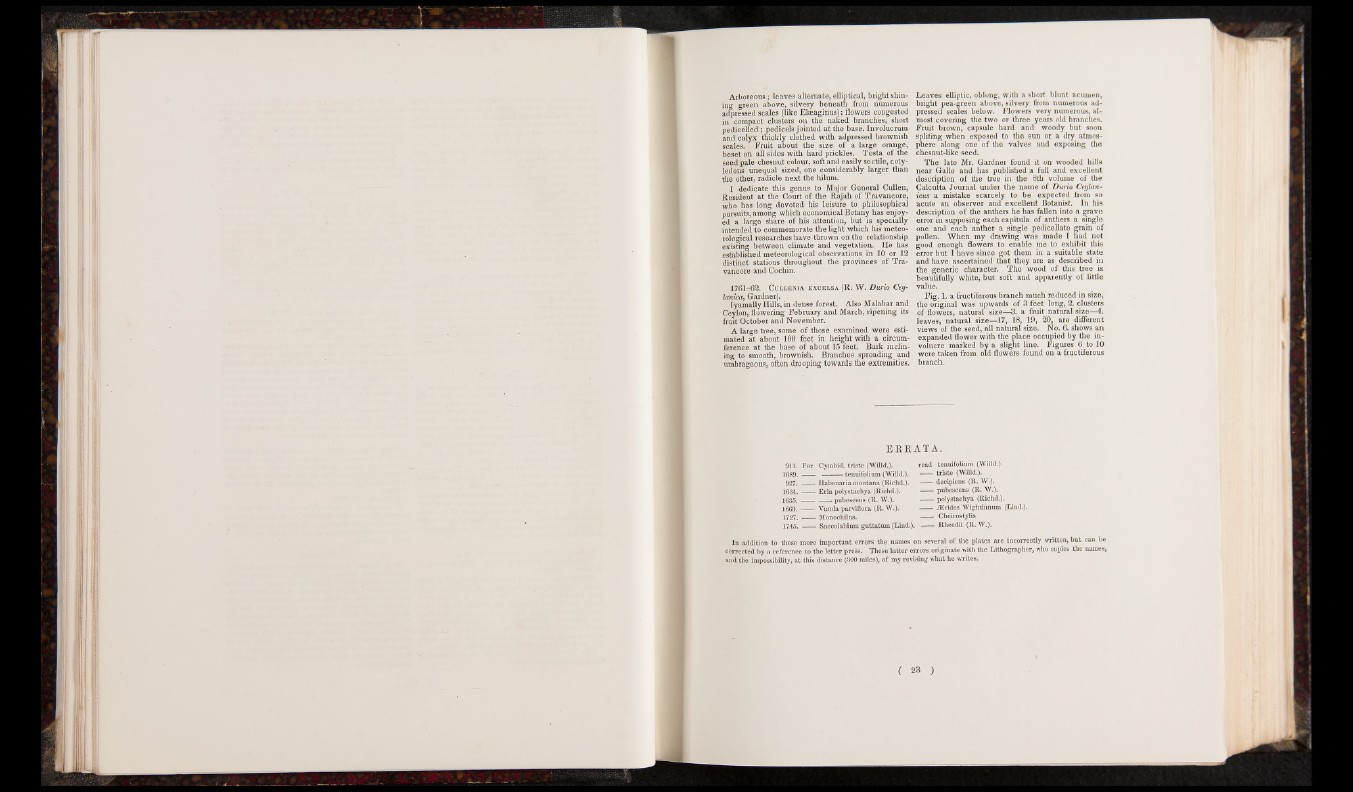
Arboreous; leaves alternate, elliptical, bright shining
green above, silvery beneath from numerous
adpressed scales (like Elaeaginus); flowers congested
in compact clusters on the naked branches, short
pedicelled; pedicels jointed at the base. Involucrum
and calyx thickly clothed with adpressed brownish
scales. Fruit about the size of a large orange,
beset on all sides with hard prickles. Testa of the
seed pale chesnut colour, soft and easily sectile, cotyledons
unequal sized, one considerably larger than
the other, radicle next the hilum.
I dedicate this genus to Major General Cullen,
Resident at the Court of the Rajah of Travancore,
who has long devoted his leisure to philosophical
pursuits, among which economical Botany has enjoyed
a large share of his attention, but is specially
intended to commemorate the light which his meteorological
researches have thrown on the relationship
existing between climate and vegetation. He has
established meteorological observations in 10 or 12
distinct stations throughout the provinces of Travancore
and Cochin.
1761-62. CuiiLENiA excelsa (Ri W. Durio Cey-
lanica, Gardner).
Iyamally Hills, in dense forest. Also Malabar and
Ceylon, flowering February and March, ripening its
fruit October and November.
A large tree, some of those examined were estimated
at about 100 feet in height with a circumference
at the base of about 15 feet. Bark inclining
to smooth, brownish. Branches spreading and
umbrageous, often drooping towards the extremities.
Leaves elliptic, oblong, with a short blunt acumen,
bright pea-green above, silvery from numerous adpressed
scales below. Flowers very numerous, almost
covering the two or three years old branches.
Fruit brown, capsule hard and woody but soon
spliting when exposed to the sun or a dry atmosphere
along one of the valves and exposing the
chesnut-like seed.
The late Mr. Gardner found it on wooded hills
near Galle and has published a full and excellent
description of the tree in the 8th volume of the
Calcutta Journal under the name of Durio Ceylan-
icus a mistake scarcely to be expected from so
acute an observer and excellent Botanist. In his
description of the anthers he has fallen into a grave
error in supposing each capitula of anthers a single
one and each anther a single pedicellate grain of
pollen. When my drawing was made I nad not
good enough flowers to enable me to exhibit this
error but I have since got them in a suitable state
and have ascertained that they are as described in
the generic character. The wood of this tree is
beautifully white, but soft and apparently of little
value.
Fig. 1. a fructiferous branch much reduced in size,
the original was upwards of 3 feet long, 2. clusters
of flowers, natural size—3. a fruit natural size—4.
leaves, natural size—17, 18, 19, 20, are different
views of the seed, all natural size. No. 6. shows an
expanded flower with the place occupied by the involucre
marked by a slight line. Figures 6 to 10
were taken from old flowers found on a fructiferous
branch.
ERRATA.
911. For Cymbid. triste (Willd.).
1689. ----- ---------tenuifolium (Willd.).
927. r—— Habenaria montana (Richd.).
1634. ------Eria polystachya (Richd.).
1635. ........ ...pubescens (R. W.).
1669. Vanda parviflora (R. W.).
1727. ----- Monochilus.
1745.----- Saccolabium guttatum (Lind.).
read tenuifolium (Willd.).
------triste (Willd.).
—— decipiens (R. W.).
------pubescens (R. W.).
' —— polystachya (Richd.).
—— iErides Wightianum (Lind.).
. Cheirostylis
— Rheedii (R. W.)-
In addition to these more important errors the names on several of, the plates are incorrectly written, but can be
corrected by a reference to the letter press. These latter errors originate with the Lithographer, who copies the names,
and the impossibility, at this distance (300 miles), of my revising what he writes.